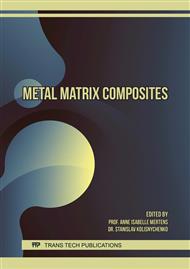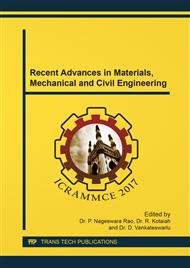[1]
Hashim J, Looney L, Hashmi M.S. J (2002). Particle Distribution in Cast Metal Matrix Composites-Part I, Journal of Materials Processing Technology, Vol. 123, p.251–257.
DOI: 10.1016/s0924-0136(02)00098-5
Google Scholar
[2]
Kok M (2005). Production and Mechanical Properties of Al2O3-Particle Reinforced 2024 Aluminum Alloy Composites, Journal of Materials Processing Technology, vol. 161, p.381–387.
DOI: 10.1016/j.jmatprotec.2004.07.068
Google Scholar
[3]
Naher S, Brabazon D, Looney L (2007). Computational and Experimental Analysis of Particulate Distribution during Al–Sic MMC Fabrication, Composites: Part A, Vol. 38, p.719–729.
DOI: 10.1016/j.compositesa.2006.09.009
Google Scholar
[4]
Fatih T, Ayfer K, Ahmet K (2010). Processing and Micro Structural Characterization of AA 1070 and AA 6063 Matrix B4CpReinforced Composites, Materials and Design, Vol. 31, pp. S87–S91.
DOI: 10.1016/j.matdes.2009.11.064
Google Scholar
[5]
Ashok B (2012). Metallurgical and Mechanical Characterization of Stir Cast AA6061-T6–Alnp Composite, Materials and Design, Vol. 40, p.52–58.
DOI: 10.1016/j.matdes.2012.03.038
Google Scholar
[6]
Hemalatha K, Venkatachalapathy V, Alagumurthy N K, (2013). Processing and Synthesis of Metal Matrix Al 6063/Al2o3 Metal Matrix Composite by Stir Casting Process, International Journal of Engineering Research and Applications, Vol. 3, pp.1390-1394.
Google Scholar
[7]
Balaji V, Sateesh N, Hussain M M, (2015). Manufacture of Aluminium Metal Matrix Composite (Al7075-SiC) by Stir Casting Technique, Materials Today: Proceedings, pp.3403-3408.
DOI: 10.1016/j.matpr.2015.07.315
Google Scholar
[8]
Jaydevan K R and Sijo M T, (2016). Analysis of Stir Cast Aluminium Silicon Carbide Metal Matrix Composite: A comprehensive Review, Procedia Technology, Vol. 24, pp.379-385.
DOI: 10.1016/j.protcy.2016.05.052
Google Scholar
[9]
Uhlmann D R, Chalmers B, Jackson K A, (1964). Interaction between Particles and a Solid-Liquid Interface, Journal of Applied Physics, Vol. 35, pp.2986-2993.
DOI: 10.1063/1.1713142
Google Scholar
[10]
Shangguan D, Ahuja S, Stefanescu D M, (1992). An Analytical Model for the Interaction between an Insoluble Particle and an Advancing Solid-liquid Interface, Metallurgical Transactions A, Vol. 23, pp.669-680.
DOI: 10.1007/bf02801184
Google Scholar
[11]
Ferguson J B, Kaptay G, Schultz B F, Rohatgi P K, CHO K, Kim C, (2014). Brownian motion Effects on Particle Pushing and Engulfment during Solidification in Metal-Matrix Composites, Metallurgical and Materials Transactions A, Vol. 45, p.4635–4645.
DOI: 10.1007/s11661-014-2379-x
Google Scholar
[12]
Nair N, Mehta V, Sutaria M P, (2016). Effect of Thermal Parameters on Dispersion of Particles in Cast Aluminium Matrix Composite, Transactions of 64th IFC, pp.21-24.
Google Scholar
[13]
Kim J K & Rohatgi P K, (1998). An Analytical Solution of the Critical Interface Velocity for the Encapturing of Insoluble Particles by a Moving Solid-liquid Interface, Metallurgical and Materials Transactions A, Vol. 29, p.351–358.
DOI: 10.1007/s11661-998-0186-y
Google Scholar
[14]
Garvin J W & Udaykumar H S, (2003). Particle-Solidification Front Dynamics Using a Fully Coupled Approach, Part I: Methodology, Journal of Crystal Growth, Vol. 252, p.451–466.
DOI: 10.1016/s0022-0248(03)00941-2
Google Scholar



